
Giambologna, also known as Jean de Boulogne (French), Jehan Boulongne (Flemish) and Giovanni da Bologna (Italian), was the last significant Italian Renaissance sculptor, with a large workshop producing large and small works in bronze and marble in a late Mannerist style.

Cosimo I de' Medici was the second Duke of Florence from 1537 until 1569, when he became the first Grand Duke of Tuscany, a title he held until his death.
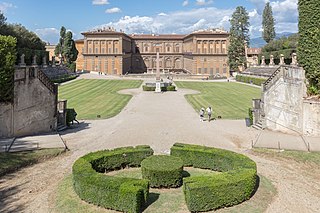
The Boboli Gardens is a historical park of the city of Florence that was opened to the public in 1766. Originally designed for the Medici, it represents one of the first and most important examples of the Italian garden, which later served as inspiration for many European courts. The large green area is a real open-air museum with statues of various styles and periods, ancient and Renaissance that are distributed throughout the garden. It also has large fountains and caves, among them the splendid Buontalenti grotto built by the artist, architect, and sculptor Bernardo Buontalenti between 1536 and 1608.

Garden gnomes are lawn ornament figurines of small humanoid creatures based on the mythological creature and diminutive spirit which occur in Renaissance magic and alchemy, known as gnomes. They also draw on the German folklore of the dwarf.

The Forte di Belvedere or Fortezza di Santa Maria in San Giorgio del Belvedere is a fortification in Florence, Italy.

Arieh Lieb "Arik" Einstein was an Israeli singer, actor, comedian and screenwriter. He was a pioneer of Israeli rock music and was named "the voice of Israel." Through both high public and critical acclaim, Einstein is regarded as one of the greatest, most popular, and most influential Israeli artists of all time.
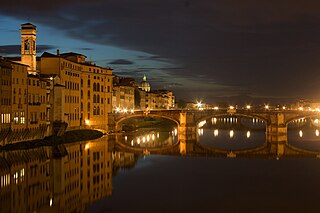
The Ponte Santa Trinita is a Renaissance bridge in Florence, Italy, spanning the Arno. The Ponte Santa Trìnita is the oldest elliptic arch bridge in the world, characterised by three flattened ellipses. The outside spans each measure 29 m (95 ft) with the centre span being 32 m (105 ft) in length. The two neighbouring bridges are the Ponte Vecchio, to the east, and the Ponte alla Carraia to the west.
Events from the year 1560 in art.

The Villa di Pratolino was a Renaissance patrician villa in Vaglia, Tuscany, Italy. It was mostly demolished in 1822. Its remains are now part of the Villa Demidoff, 12 km north of Florence, reached from the main road to Bologna.
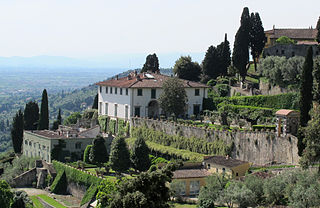
The Medici villas are a series of rural building complexes in Tuscany which were owned by members of the Medici family between the 15th century and the 17th century. The villas served several functions: they were the country palaces of the Medici, scattered over the territory that they ruled, demonstrating their power and wealth. They were also recreational resorts for the leisure and pleasure of their owners; and, more prosaically, they were the centre of agricultural activities on the surrounding estates. In 2013, the Medici villas were added to UNESCO's World Heritage list.
Events from the year 1552 in art.

The Villa di Castello, near the hills bordering Florence, Tuscany, central Italy, was the country residence of Cosimo I de' Medici, Grand Duke of Tuscany (1519-1574). The gardens, filled with fountains, statuary, and a grotto, became famous throughout Europe. The villa also housed some of the great art treasures of Florence, including Sandro Botticelli's Renaissance masterpieces The Birth of Venus and Primavera. The gardens of the Villa had a profound influence upon the design of the Italian Renaissance garden and the later French formal garden.
Valerio Cioli (1529–1599) was an Italian Renaissance sculptor.

The Giardino Bardini is an Italian Renaissance garden of the Villa Bardini in the hilly part of Oltrarno, offering fine views of Florence, Italy. Opened only recently to the public, it is one of Florence's well kept secrets.

The Italian Renaissance garden was a new style of garden which emerged in the late 15th century at villas in Rome and Florence, inspired by classical ideals of order and beauty, and intended for the pleasure of the view of the garden and the landscape beyond, for contemplation, and for the enjoyment of the sights, sounds and smells of the garden itself.

Italian garden typically refers to a style of gardens, wherever located, reflecting a number of large Italian Renaissance gardens which have survived in something like their original form. In the history of gardening, during the Renaissance, Italy had the most advanced and admired gardens in Europe, which greatly influenced other countries, especially the French formal garden and Dutch gardens and, mostly through these, gardens in Britain.
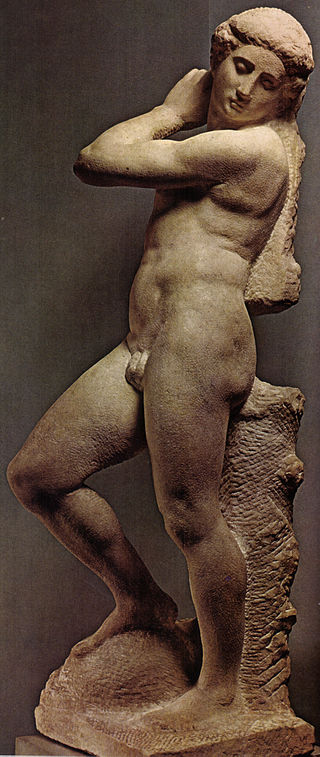
Apollo, also known as Apollo-David, David-Apollo, or Apollino, is a 1.46 m unfinished marble sculpture by Michelangelo that dates from approximately 1530. It now stands in the Bargello museum in Florence.
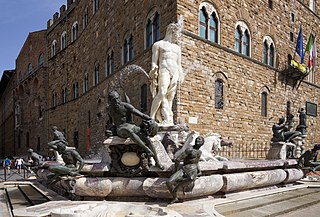
The Fountain of Neptune in Florence, Italy, is situated in the Piazza della Signoria, in front of the Palazzo Vecchio. The fountain was commissioned by Cosimo I de' Medici in 1559 to celebrate the marriage of Francesco de' Medici I to Grand Duchess Joanna of Austria. Cosimo I de' Medici was the Duke of Florence from 1537-1569 and responsible for a vast number of architectural and artistic elements in Florence that still exist today.

Nano Morgante was an Italian dwarf who was a famed buffoon and court jester in the court of Cosimo I de' Medici, Grand Duke of Tuscany. Morgante was ironically nicknamed after the giant from the poem of the same name by Luigi Pulci. He was the most celebrated of the five dwarves of the Medici court at the Palazzo Pitti.

Portrait of the Dwarf Nano Morgante is a 1552 double-sided painting offering front and back views on either side of the canvas by Bronzino of Nano Morgante the famed buffoon dwarf of Cosimo I de' Medici, Grand Duke of Tuscany who is also immortalized in Valerio Cioli's Fontana del Bacchino at the Boboli Gardens in Florence. The work was commissioned from Bronzino by Cosimo. It portrays Morgante on both sides as a bird-catcher, as he was not permitted to hunt bigger game, this being a pursuit reserved for persons of greater echelon. Morgante is depicted respectively from the front and back at two subsequent moments of the action: at the front we see him before the hunt, holding an owl in a snare to be used as a bait to capture a jay that is flying in the air. A duo of rare swallowtail butterflies cover his genitals; these were discovered recently, when the painting was last restored. From behind, we see him just about to turn towards the viewer, anxious to visually boast of his take.

















